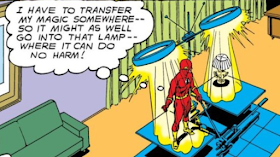You can be part of the problem or part of the solution. And I can think of no icon-level character more problematic than Green Lantern Hal Jordan, so with an assist from Absorbacommenter Cobramisfit I set about fixing him.
The essential problems with the (current) Green Lantern mythos are:
- Green Lantern has become all about the Corps;
- Therefore it is too space-based and space is hard to identify with;
- as a result, Green Lantern's terrestrial rogues gallery has atrophied;
- Hal is not the centerpiece of any sort of dynasty, plus
- Hal is an idiot.
Green Lantern has become all about the Corps. Would anyone even try to deny this? There are 3600 (or there used to be) other Green Lanterns, and every writer seems to determine to introduce one ("Who's even WEIRDER than the last one! Space, emmiright?"). And every single one is more interesting than Hal (although he is the prettiest). Huge effort has been expended by creators over the years trying to make the Corps (and their internal politics) more and more INTERESTING to us (include Geoff Johns' introduction of the Rainbow Corps). I declare those mostly a failure. The Corps is ... tedious.
In addition, it's a gazillion sentients with the same powers as Our Hero. Sure, there were always a few Super-folk running around the DCU, but never THOUSANDS of them.
 |
| Unless you count the Superman Emergency Squad and all the inhabitants of the bottle city of Kandor. Which we don't. For some reason. |
Sure, many writers have tried individuating the GLs by trying to make the case they all use their powers in different WAYS, blah blah. Pfft; shovel faster.
 |
| Shut up, Hal. |
The magic lamp that is the Green Lantern ring has been shown to do any number of ridiculous things (including accidentally turn Poor Tom Kalmaku into a seagull).
It makes you wonder why Hal didn't just turn every opponent into a seagull and rename himself "Green Seagullmaker".
But the fact remains that almost invariably it's just used to make 'green energy constructs'; who cares WHAT those constructs are?
Look, stop shoving so many Lanterns down our throats. It only dilutes the concept and makes it evern harder to view Hal as special (except in the sense that, you know, he takes a short bus to Oa).
GLs are basically like wild west federal marshalls (IN SPAAAAACE!).

I have watched more than my share of old western shows and flicks, and I can't recall any one where the federal marshal has an exciting trip to Washington/Oa to attend a meeting with all the other marshals to discuss how they are going to deal with, um, widespread prairie dogs infestations or the like. Marshals are one person by themselves dealing with crap on the frontier (as in EARTH). You can acknowledge the Corps with references and an OCCASIONAL sojourn, but focus on Hal doing his ring-thing on Earth.
Yes, on Earth. Stop making the same mistake with Green Lantern that is often made with Aquaman: spending too much time on the part of his job we can't identify with. With Aquaman, that is, of course, Atlantis. With Green Lantern, it's space. It's hard enough to get Americans to care about real-life events in real-life countries-that-aren't-the-USA. Don't make Aquaman and Green Lantern that much less likely to interest readers by focusing on events so far removed from the world at hand.
While on Earth, focus on Hal's Earth-based foes. Hector Hammond, Karshon the Shark, Dr. Polaris, Black Hand, Sonar, the Tattooed Man. They are pretty formidable and more has been made of stupider villains, for sure. Re-purpose a few appropriate villains, like, say, Dr. Light, as Lantern rogues and they'll get a new lease on life.
Heck, Rainbow Raider, who uses COLOR to control EMOTIONS is pretty much made to order for Hal.
Speaking of the 'emotional spectrum', the Corps of Another Color can be used to solve another problem: the lack of a Green Lantern dynasty. As mentions, as part of the Green Lantern Corps, Hal is just one of many equals. Use the Spectrum Corps to solve that. Willpower is in fact what we use to keep our emotions in check and may sure they benefit us rather than hold us back. Let that be the relationship of the Green Lantern Corps to the other ones. Make a unified Lantern Corps, with the GLs being in charge.
Then replicate that on Earth. Hal is the GL and in charge of a team of Other-Color Lanterns. Let Guy be the Red One, Jessica be the Yellow One, and so on. You can have a bunch of familiar characters as Lanterns, with a natural different spin on their abilities, and have Hal coordinating them as the central figure in a heroic dynasty of Lanterns.
But, you wisely interject, how can you do that when Hal is, well, not the brightest Lantern in the sky? Okay, fine; Hal's an idiot. The solution for that is pretty simple: let Hal be an idiot.
Or more accurately, dismiss intellectual acuity as some sort of absolute virtue or sine qua non of being a superhero.
SO many heroes are hypergenius scientists. In their DOWNTIME. Superman puttering about his Fortress of Solitude inventing robots that -- somehow -- have his powers and are functional AIs that can not only pass the Turing Test but pass it AS SUPERMAN. Batman inventing, well, anything he needs in his never-ending war against crime.
Wonder Woman, lest you forget, invented the Purple Healing Ray. Barry Allen invented the Comic Effing Treadmill. Aquaman didn't invent Serum X but he did guide the project and at least Arthur went to college, where he got a degree in marine biology.
The only thing Hal Jordan ever invented was the boxing glove.
So, LET Hal Jordan be a, um... 'non-intellectual'. Shouldn't non-intellectuals have a high-level hero to look up to? Besides, the only kind of intelligence Hal needs is EMOTIONAL intelligence. He should have a natural understanding of his feelings and the feelings of others, be able to check and channel those. That should be the quality the Guardians are looking for in Green Lanterns. Remember that originally in the Silver Age they were looking for people who were fearless. Such people are often not the brightest.
By the same token, stop trying to shovel the hooey that Hal Jordan is THE GREATEST GREEN LANTERN OF THEM ALL.
Hal Jordan doesn't need to be the BEST Green Lantern of them all. He's not the best one; he's just the most typical one.
Hal's a military man, picked for a paramilitary space police force. Hal is solid. Hal is reliable. Hal doesn't overthink things and isn't crippled by doubt and second-guessing. Hal doesn't question orders needlessly, stays focused on his mission to the exclusion of distractions, and has a disregard for his personal well-being when it gets in the way of the mission. Hal's confidence lets him do things that others couldn't (regardless of whether it is well founded). And sometimes his out-of-the-box thinking saves the day because he never learned where the box was to begin with.
These aren't bad qualities; they are good ones. This kind of fortitude and doggedness are exactly the qualities that more intellectual types often lack and whose absence holds them back. They are among the qualities that military and police forces rightly prize and we should honor Hal Jordan for having them, rather than focusing on the fact that he could never invent something as amazing as Batarang X.
There's a reason they picked Ryan Reynolds to play him rather than Jake Gyllenhaal. Does Ryan Reynolds strike you as an intellectual? No. Is he very good at what he does? Yes; and is likable while doing it.
Do the above and let Hal be Hal... and Green Lantern will be fixed.
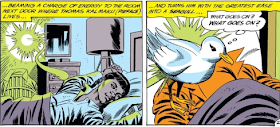 |
| "What goes on?" is a much better catchphrase than "jumping fish-hooks', so run with it, Tom. |
It makes you wonder why Hal didn't just turn every opponent into a seagull and rename himself "Green Seagullmaker".
 |
| Probably because even a seagull is more competent than Hal, so turning opponents into seagulls would -- somehow -- backfire against him |
 |
| God knows, Hal doesn't care. |
Look, stop shoving so many Lanterns down our throats. It only dilutes the concept and makes it evern harder to view Hal as special (except in the sense that, you know, he takes a short bus to Oa).
GLs are basically like wild west federal marshalls (IN SPAAAAACE!).

I have watched more than my share of old western shows and flicks, and I can't recall any one where the federal marshal has an exciting trip to Washington/Oa to attend a meeting with all the other marshals to discuss how they are going to deal with, um, widespread prairie dogs infestations or the like. Marshals are one person by themselves dealing with crap on the frontier (as in EARTH). You can acknowledge the Corps with references and an OCCASIONAL sojourn, but focus on Hal doing his ring-thing on Earth.
Yes, on Earth. Stop making the same mistake with Green Lantern that is often made with Aquaman: spending too much time on the part of his job we can't identify with. With Aquaman, that is, of course, Atlantis. With Green Lantern, it's space. It's hard enough to get Americans to care about real-life events in real-life countries-that-aren't-the-USA. Don't make Aquaman and Green Lantern that much less likely to interest readers by focusing on events so far removed from the world at hand.
While on Earth, focus on Hal's Earth-based foes. Hector Hammond, Karshon the Shark, Dr. Polaris, Black Hand, Sonar, the Tattooed Man. They are pretty formidable and more has been made of stupider villains, for sure. Re-purpose a few appropriate villains, like, say, Dr. Light, as Lantern rogues and they'll get a new lease on life.
 |
| It's not that hard, people. Unlike Hal's head. |
Heck, Rainbow Raider, who uses COLOR to control EMOTIONS is pretty much made to order for Hal.
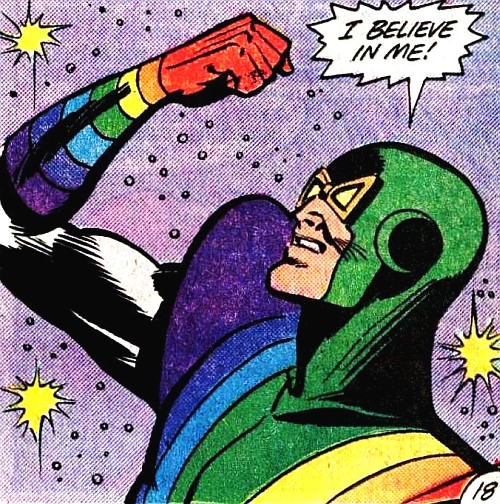 |
| As do we all, Roy. |
Speaking of the 'emotional spectrum', the Corps of Another Color can be used to solve another problem: the lack of a Green Lantern dynasty. As mentions, as part of the Green Lantern Corps, Hal is just one of many equals. Use the Spectrum Corps to solve that. Willpower is in fact what we use to keep our emotions in check and may sure they benefit us rather than hold us back. Let that be the relationship of the Green Lantern Corps to the other ones. Make a unified Lantern Corps, with the GLs being in charge.
Then replicate that on Earth. Hal is the GL and in charge of a team of Other-Color Lanterns. Let Guy be the Red One, Jessica be the Yellow One, and so on. You can have a bunch of familiar characters as Lanterns, with a natural different spin on their abilities, and have Hal coordinating them as the central figure in a heroic dynasty of Lanterns.
But, you wisely interject, how can you do that when Hal is, well, not the brightest Lantern in the sky? Okay, fine; Hal's an idiot. The solution for that is pretty simple: let Hal be an idiot.
Or more accurately, dismiss intellectual acuity as some sort of absolute virtue or sine qua non of being a superhero.
SO many heroes are hypergenius scientists. In their DOWNTIME. Superman puttering about his Fortress of Solitude inventing robots that -- somehow -- have his powers and are functional AIs that can not only pass the Turing Test but pass it AS SUPERMAN. Batman inventing, well, anything he needs in his never-ending war against crime.
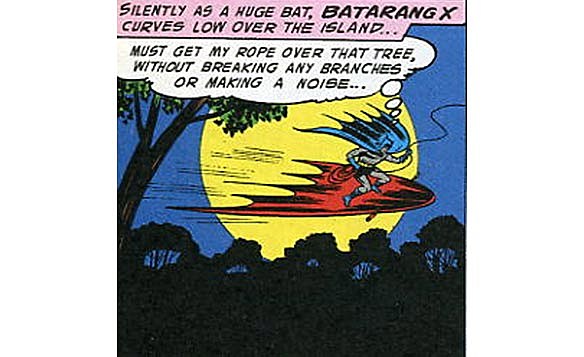 |
| Even the amazing BATARANG X, painted red for stealth. |
Wonder Woman, lest you forget, invented the Purple Healing Ray. Barry Allen invented the Comic Effing Treadmill. Aquaman didn't invent Serum X but he did guide the project and at least Arthur went to college, where he got a degree in marine biology.
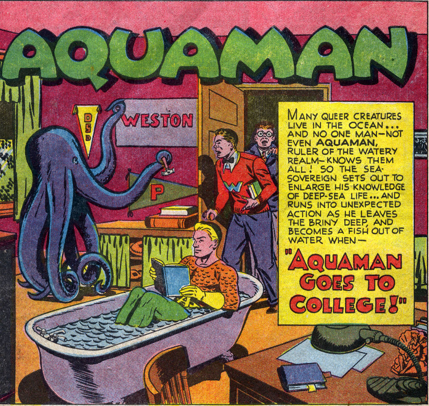 |
| And where he was vice-president of Hillel. |
The only thing Hal Jordan ever invented was the boxing glove.
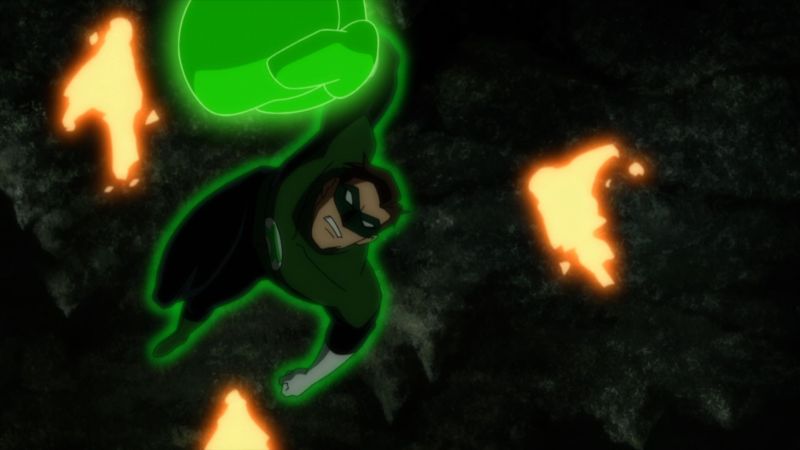 |
| Don't tell him otherwise; it would break his heart. |
So, LET Hal Jordan be a, um... 'non-intellectual'. Shouldn't non-intellectuals have a high-level hero to look up to? Besides, the only kind of intelligence Hal needs is EMOTIONAL intelligence. He should have a natural understanding of his feelings and the feelings of others, be able to check and channel those. That should be the quality the Guardians are looking for in Green Lanterns. Remember that originally in the Silver Age they were looking for people who were fearless. Such people are often not the brightest.
By the same token, stop trying to shovel the hooey that Hal Jordan is THE GREATEST GREEN LANTERN OF THEM ALL.
| To be fair, he's a pilot, and they are used to be strapped in during flight. |
Hal Jordan doesn't need to be the BEST Green Lantern of them all. He's not the best one; he's just the most typical one.
Hal's a military man, picked for a paramilitary space police force. Hal is solid. Hal is reliable. Hal doesn't overthink things and isn't crippled by doubt and second-guessing. Hal doesn't question orders needlessly, stays focused on his mission to the exclusion of distractions, and has a disregard for his personal well-being when it gets in the way of the mission. Hal's confidence lets him do things that others couldn't (regardless of whether it is well founded). And sometimes his out-of-the-box thinking saves the day because he never learned where the box was to begin with.
 |
| The point here is not that Hal took ten hours to figure it out. It's that he WOULD. |
These aren't bad qualities; they are good ones. This kind of fortitude and doggedness are exactly the qualities that more intellectual types often lack and whose absence holds them back. They are among the qualities that military and police forces rightly prize and we should honor Hal Jordan for having them, rather than focusing on the fact that he could never invent something as amazing as Batarang X.
 |
| Or safely take a shower. |
There's a reason they picked Ryan Reynolds to play him rather than Jake Gyllenhaal. Does Ryan Reynolds strike you as an intellectual? No. Is he very good at what he does? Yes; and is likable while doing it.
Do the above and let Hal be Hal... and Green Lantern will be fixed.




